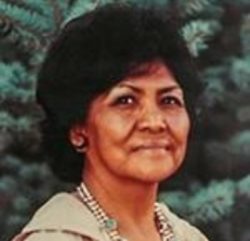Mae Timbimboo Parry is of the Northwestern Band of the Shoshone Nation of Utah. She spent part of her life in Washakie, and the other part in Clearfield, Utah. Traditionally, the Shoshone made clothing and accessories from buckskin to clothes themselves. Mae tanned the buckskin. Her grandson remembers that in her home, it smelled of smoked buckskin. Mae took the buckskin fashioned into gloves and decorated them. Men and women made gloves. She used beautifully colored beads and sewed them into necklaces, or into moccasins. Their tribe was known for their beadwork and the pattern of the Mountain Rose, a full red rose with green leaves. Members of the tribe hand-sewed buckskin clothing and moccasins out of necessity. In the Twentieth Century, when Mae threaded each bead, it was for someone she loved.


